10 Most Famous Cityscape Paintings
Cityscapes have been a pop subject for many artists throughout centuries of dissimilar art movements. Since the Italian Renaissance, artists have sought to portray the cities they have either visited or lived in to capture the beauty and individuality of each one.
There are several cities throughout the world that have long served as centers for artistic expression and artists from various movements take depicted these cities with their own distinct flavor.
With some artists focusing their unabridged careers to painting cityscapes, there are numerous works in existence that are extremely impressive depictions of certain cities.
In this article, we will discuss some of the well-nigh famous cityscape paintings and too explore the artists who created them, equally well as the reasons behind their creations.
Famous Paintings of Cityscapes
one. Paris Street; Rainy 24-hour interval – Gustave Caillebotte
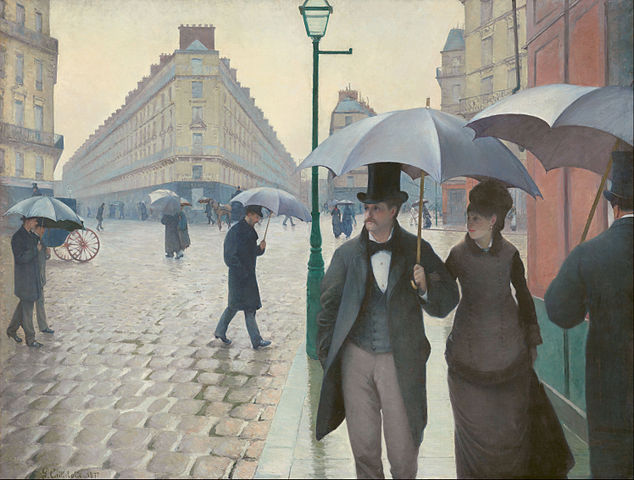
Paris is ane of the most common cities that artists focus their efforts on in creating cityscape paintings. Gustave Caillebotte was an artist that was built-in and raised in Paris during the mid-19th century when a number of different fine art movements were in their most determinative years.
Caillebotte is 1 of the more notable cityscape artists in history every bit his works were done with a masterful level of realism, even so as well contained a sense of the emotional feelings or underlying letters that the artist was attempting to convey.
Caillebotte's well-nigh famous painting is an 1877 work titled Paris Street; Rainy Twenty-four hour period. The painting depicts a scene in which various individuals are walking across the Place de Dublin, which was a popular surface area of Paris during the time in which the work was painted.
Like many other masterful Realism paintings from this era, this piece of work contains incredible details, simply the characteristics that most critics and historians are drawn to is the proportion and composition.
Many critics believe that this painting was heavily influenced past photography, but the painting received loftier praise from nigh every major critic and museum at the time. Caillebotte was praised for his uncanny ability to brand the streets appear every bit if they are actually wet with the fallen rain.
ii. The Boulevard Montmartre at Night – Camille Pissarro
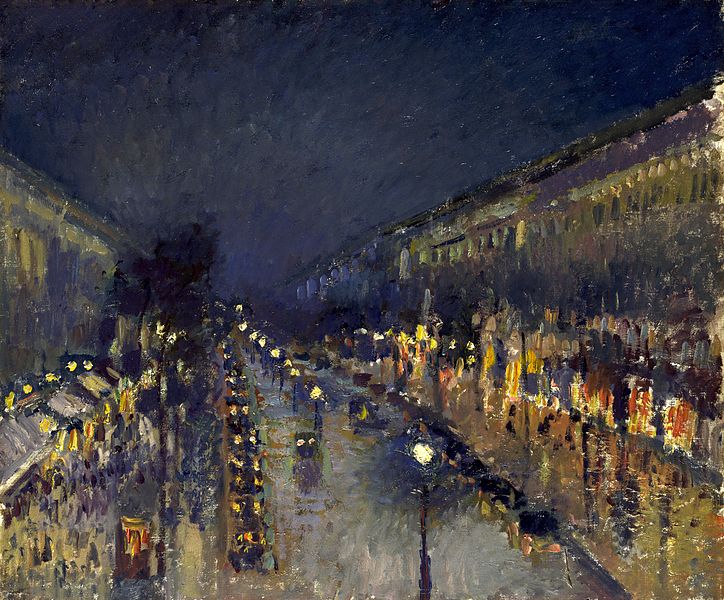
Camille Pissarro is regarded equally the begetter of the Impressionist move, which took place during the mid-to-late 19th century. Many of his works eye on cityscapes in both daytime and nighttime and Pissarro became famous for his ability to describe cityscapes in an Impressionist form.
He was an specially gifted landscape creative person, just he chose to paint cities and landscapes that held meaning meaning to the people that lived in and around the locations.
One of Pissarro's almost famous works is known for its incredible dark atmosphere. The piece of work is titled The Boulevard Montmartre at Night and was completed in 1897 after a time in which Pissarro spent a few weeks staying in the aforementioned room that overlooked the Boulevard Montmartre.
Historians record that the creative person spent weeks painting numerous works that focused on the same perspective and angle of the famous painting, in both 24-hour interval and dark.
This painting is known for Pissarro's masterful brushstrokes and use of color to display the glowing lights and how they illuminated the streets and storefronts of the famous Boulevard Montmartre.
3. Cityscape I – Richard Diebenkorn
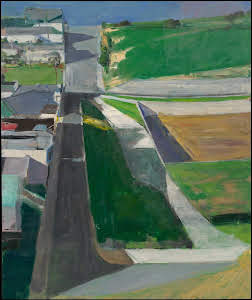
American painter Richard Diebenkorn is well-known as one of the most famous abstract artists that also worked in a multifariousness of dissimilar painting styles and genres, including cityscapes.
He grew up in San Francisco and his family unit recognized his artistic inclination from a very early historic period as Diebenkorn was said to take been an avid creator of drawings from the time he was just a few years erstwhile.
I of Diebenkorn'south nigh highly-celebrated paintings is a cityscape that depicts a simple hillside road that features houses on one side and lush, green grassy hills on the other.
Diebenkorn was known to have become a well-known artist in his youth when he worked with abstruse expressionism concepts, simply he would later motion on to create figurative works such as this particular painting titled Cityscape I.
This detail painting was washed in 1963 while Diebenkorn was enrolled at Stanford Academy as the institution's kickoff artist-in-residence.
4. Nighthawks – Edward Hopper
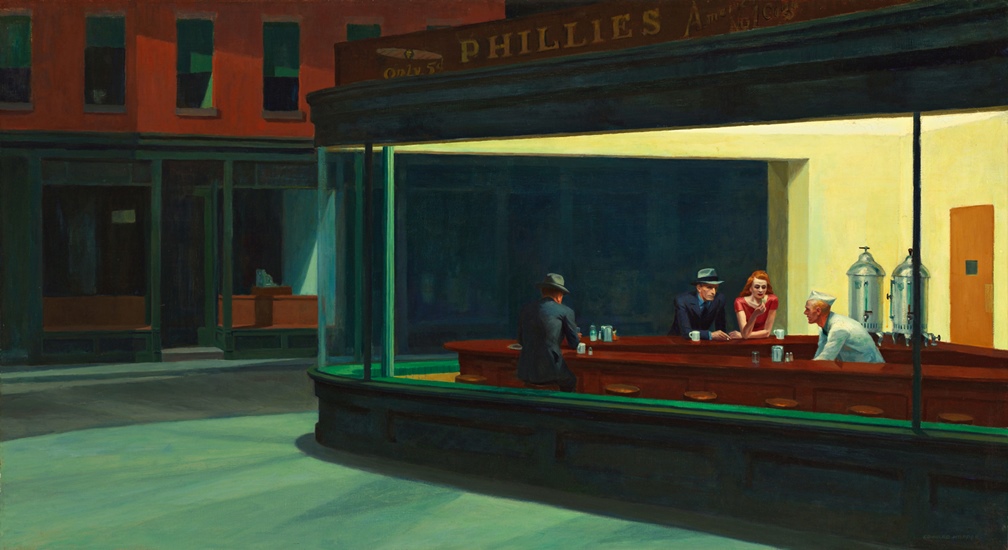
Edward Hopper is recognized equally one of the most famous American painters from the early-to-mid 20th century. It was a fourth dimension in which industrialization had greatly shifted the American mural and culture from that of a farming lodge to one in which cities and urban areas were more than prominent.
Hopper sought to depict this change in many of his paintings, especially during his later career.
Hopper'south most well-known painting is titled Nighthawks and was completed in 1942. It portrays a swain and woman, as well as another patron seated at a midnight cafe while a unmarried waiter behind the bar.
This scene is dominated past the abrupt, lonely nature of the city exterior the small-scale corner cafe, which is said to have meant to represent the disconnect that many people had from one another due to living in big, overpopulated cities.
The painting is viewed as one of the more than iconic scenes from American history and has been featured or inspired works ever since information technology was first exhibited.
5. View of Delft – Johannes Vermeer
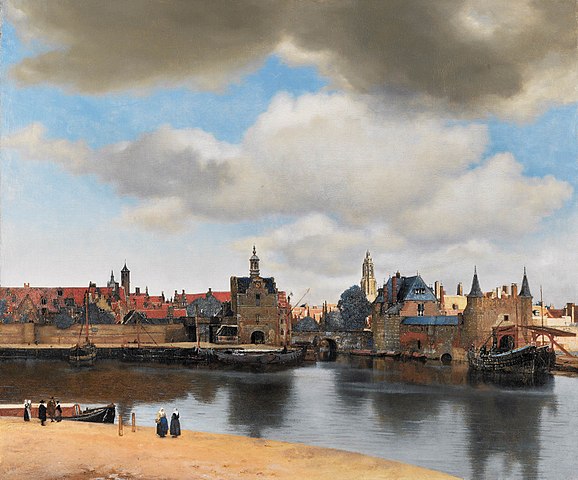
Johannes Vermeer is one of the more highly regarded members of the late Bizarre era. The Dutch artist has one of the nigh all-encompassing collections of cityscape paintings that were done with an incredible level of realism and perspective.
Many of Vermeer's paintings characteristic some of the prominent figures or other individuals he encountered, but the bulk of his most celebrated landscape or cityscapes were done to portray his dwelling city of Delft, Holland.
In fact, his virtually famous cityscape painting is titled View of Delft and was washed past Vermeer in 1661. The painting received high praise when it was starting time finished and is one of the more iconic portrayals of a Dutch cityscape from the Baroque era.
The painting depicts a somewhat cloudy sky higher up a calm River Schie, which was the prominent waterway that ran through the city.
six. The Little Street – Johannes Vermeer
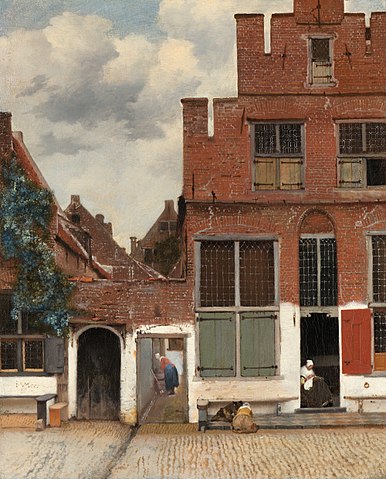
Another ane of Vermeer's about celebrated cityscapes was done in the same city, his hometown of Delft. This painting is i of the very few works that Vermeer actually signed, which makes it 1 of his more than valuable works that is still in existence. The painting is titled The Little Street and is believed to have been completed 1657 or 1658.
This work features a somewhat aboveboard view of the tranquillity, calm street that is said to have been a very common sight for various cities throughout Holland during this time.
In addition to the incredibly-realistic detail Vermeer used in the painting, critics and scholars point to the artist's use of specific angles and shapes to focus the viewer'south attention on certain areas of the painting, such as the left side and the small alleyway that's near the middle.
seven. The Stonemason'south One thousand – Canaletto
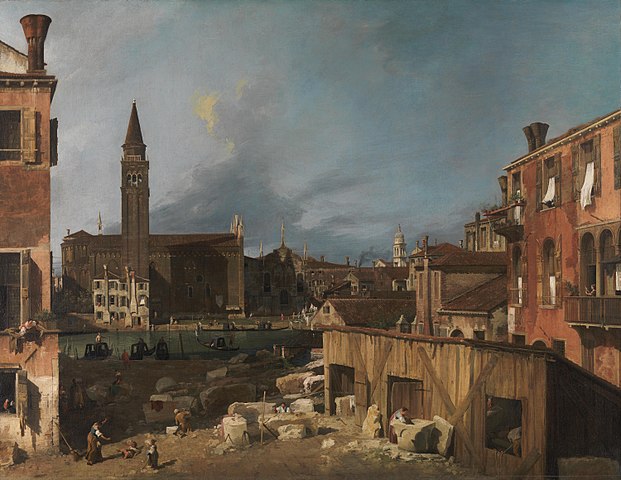
Giovanni Antonio Culvert is more commonly-known as Canaletto and is regarded as one of the most famous Italian painters that lived and worked after the terminate of the Italian Renaissance.
Canaletto was extremely gifted in terms of painting scenes that included cityscapes from the virtually prominent locations in Italy and French republic.
One of Canaletto'southward nearly famous cityscape paintings is known as The Bricklayer's One thousand and was created in 1725 when he was still living in Venice.
Also Read: Paintings of Venice
This painting was one of the many cityscapes he created that featured bright amounts of sunlight that play beyond the buildings and other structures, every bit well as the people of the modest city and stonemason's 1000.
8. Boulevard des Capucines – Claude Monet
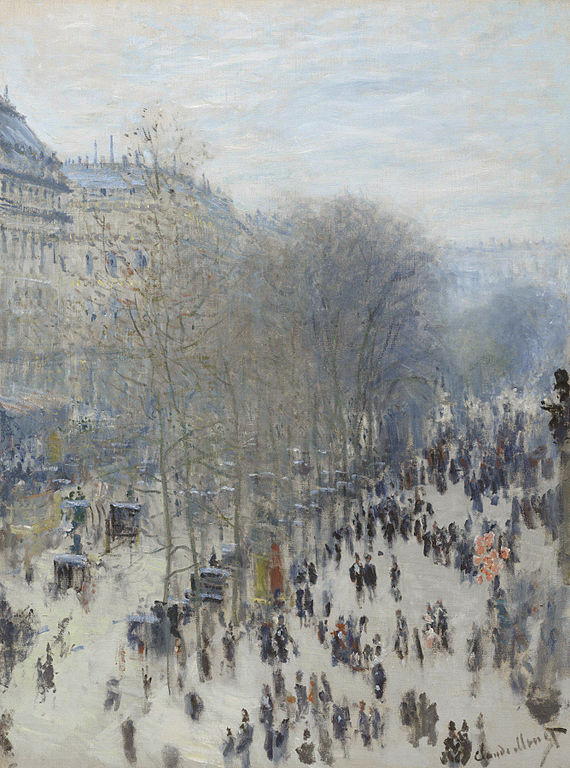
Claude Monet is widely viewed as the virtually prominent effigy from the Impressionist motility with some critics and historians dubbing him the "Begetter of Impressionism." It was Monet'due south piece of work and style that had an incredible impact on the other artists that followed after him in the Impressionist movement.
Many of his works features outdoor scenes because Monet popularized the mode of painting that was called "en plein air" which involved the artist going to the actual location to sit and paint the work instead of making a mere sketch and returning to their studio to paint the full work.
Monet's most famous cityscape work is i that is known equally Boulevard des Capucines and was completed in 1874. This detail painting features near a bird's-eye view from the humming Paris boulevard and depicts the streets every bit they were during this time, flooded with people from all walks of life.
The blue hue that dominates the painting seems to bespeak Monet'south feelings toward existence bars to the city as it is said that he much preferred to spend his fourth dimension in the outdoors whenever possible.
nine. Late Afternoon, New York, Winter, 1900 – Childe Hassam
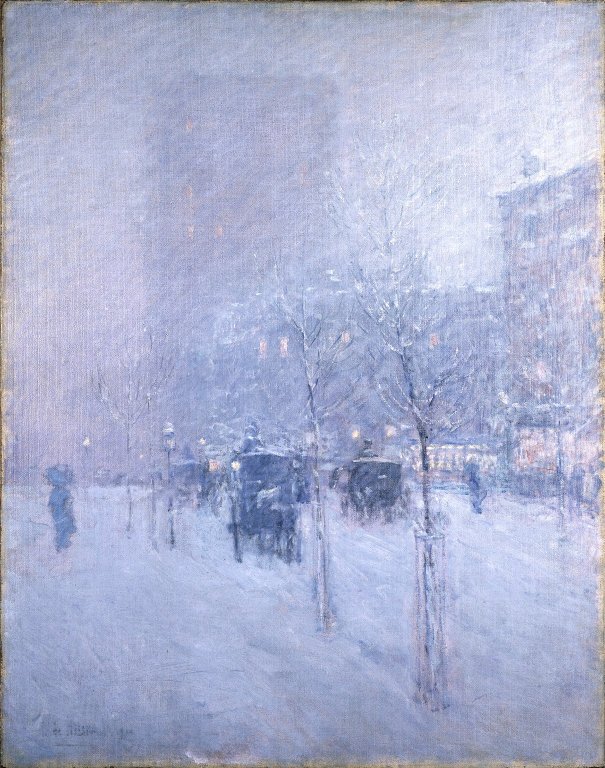
Childe Hassam was one of the most prominent Impressionist painters in America during the early 20th century. He produced a huge number of different paintings, watercolors and lithograph works that are at present considered to be amid the most widely-celebrated cityscape paintings from the fourth dimension period.
One of his paintings is said to take an uncanny resemblance to Caillebotte's Rainy Mean solar day; City Street, which was done simply a few years earlier, compared to Hassam'south 1885 piece of work.
One of Hassam'due south most famous original paintings is titled Late Afternoon, New York, Winter, 1900 and was completed during the height of his career in 1900.
This work contains a number of Impressionist characteristics and Hassam does a spectacular job painting the snowfall in a way that makes the viewer feel as if they tin sense the bite of the common cold air and feel the crunch of the snowfall beneath their feet.
Many artists have commented that painting snow-scenes is extremely difficult as it is hard to portray the light in a realistic style. Notwithstanding, Hassam has washed so beautifully in this particular work and gives the viewer a glimpse into the snowy, gloomy winters that commonly happen in Brooklyn.
ten. Paris through the Window –Marc Chagall
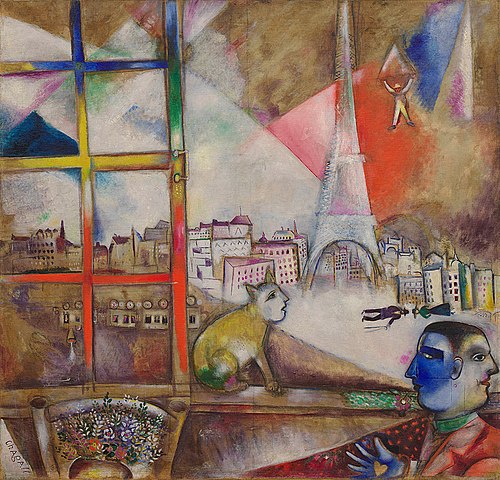
Few artists from the abstract era are as highly-regarded for their cityscape works as those from earlier art movements. Withal, Marc Chagall is one of the few painters that managed to create i of the more memorable cityscape works that feature distinctly abstract elements.
Chagall was a prominent artist during the early-to-mid 20th century when Cubism and Expressionism were the 2 near pop painting styles in America and Europe.
His 1913 painting titled Paris through the Window is i of the more iconic works that features a view of the urban center of Paris. The painting is filled with vibrant colors and intriguing shapes and forms.
The famous Eiffel Tower is prominently displayed in the painting and it is remembered as one that celebrates the diversity and vibrancy of the city.
Source: https://www.artst.org/cityscape-paintings/
0 Response to "10 Most Famous Cityscape Paintings"
Post a Comment